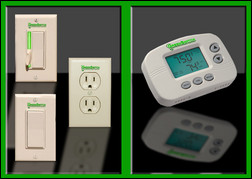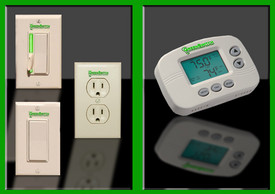Enjoy a greener lifestyle this year by adopting some of these 20 energy-saving practices. For those who don’t have the extra money to invest in an energy audit, an ENERGY STAR television or extra insulation, try taking on some of the inexpensive changes like adding LED lighting, adjusting your energy-wasting habits or making better use of existing sunlight.
1. Modify energy-wasting behavior. Monitoring devices provide real-time data on energy consumption and give homeowners the opportunity to adjust it. Scott Pigg, senior project manager with the Energy Center of Wisconsin, says “it’s hard to save electricity when the only information you have is the monthly bill.
 GreenSwitch™ takes the idea of a power strip to a whole-house level. (c) GreenSwitch LLC |
There are several devices on the market that can be installed by homeowners to show you how much electricity you’re using at any moment and then take steps to reduce your use. A few field studies have shown five to 15 percent electricity savings in homes where these were installed.” Check into such devices as the Kill A Watt EZ electricity usage monitor and Leviton’s Decora Manual ON Occupancy Sensor and Decora Manual ON Occupancy Sensor Remote Control. The Kill a Watt EZ lets you unplug an appliance and still see the readings and input local kilowatt-hour rates for dollar figures rather than just a kwh reading. Leviton’s sensors detect human motion and respond accordingly and feature sensitivity adjustments.
2. Take advantage of new tax credits. If you had been thinking about residential solar, wind and geothermal, this may be the year to take action. Federal incentives have been extended and even increased for some types. Personal tax credits are available for solar water heat, photovoltaics, wind, fuel cells, geothermal heat pumps and other solar electric technologies. Find details at the Database of State Incentives for Renewables and Efficiency.
3. Add LEDs. The technology is advancing for LEDs, or light-emitting diodes, and more are starting to arrive on the residential scene. They are in desk and under-cabinet lights, outdoor pathway and step lights, decorative string lights and residential downlights. The small light sources are the energy created by the movement of electrons through semiconductor material. Many LEDs use up to 90 percent less energy than an incandescent bulb to produce the same amount of light.
4. Consider time-of-use billing. Some utilities offer “time of use" electricity rates that vary according to the demand on the system. They charge higher rates during "peak" times when demand is highest and lower rates during "off-peak" times. Some utilities even offer incentives to customers who allow them to install control devices that allow the utility to shut off electric water heaters during peak demand. Shut-off periods are generally short so homeowners experience little reduction in service. Check with your utility to see if this is offered and if it will work for your lifestyle.
5. Switch to an Energy Star-rated TV. When your old TV is ready to be recycled, buy one that meets the latest Energy Star ratings. On average an Energy Star-qualified TV will save $35 off a consumer’s utility bills over the life of the TV, according to the Environmental Protection Agency. More than 200 models meet the qualifications, which means they are about 30 percent more efficient than non-qualified models. Visit the Energy Star Web site for details.
6. Banish phantom loads. Many televisions, kitchen appliances, computers and stereos continue to draw power even when they are switched off. According to the Department of Energy (DOE), up to 75 percent of the electricity used to power home electronics in the average home is wasted sending power to products that are turned off. Use power strips and remember to switch them to “off.” Or, consider a product like the new GreenSwitch™. Greg Hood, founder of GreenSwitch LLC, says the product is meant to bridge the behavior gap. GreenSwitch sends a radio signal to companion components in outlets around the home, taking the energy-saving idea of a power strip to a whole-house level. “Customers have the peace of mind knowing that all of those energy hogs typically left on will be turned off at the flip of a switch as they leave the house,” says Hood. The system is expandable. For example, a package of eight light switches or outlets, a master switch and a programmable thermostat would cost less than $900. If you feel comfortable changing out a light switch, the installation is easy. However, a national installation service is available.
7. Test your appliances. Use a portable electricity meter to check how many watts your appliances are using. A few simple plug-in tests will help you determine if it time to replace an appliance. Check with your utility to find out if it lends electricity meters or check out products online such as Watts up?. Learn more about energy-saving appliances here.
8. Take advantage of new technologies. Consider products such as Dow’s Styrofoam SIS™ brand Structural Insulated Sheathing in any new building project. It contains up to 80 percent post-consumer recycled content and combines the structural and water-resistive properties of wood sheathing and housewrap with the added benefit of insulation. It offers homeowners an estimated $200 to $500 in energy savings annually, depending on heating/cooling system, geographical location, energy costs, wall assembly configuration and thickness of insulation installed. It also meets or exceeds residential code for structural shear bracing, water-resistive barrier and thermal protection in one product.
 A blower door test to check for air leakage in the home is performed at a bungalow in Chicago. (c) Historic Chicago Bungalow Association |
9. Schedule a blower-door test. It’s difficult to know just where those holes and cracks are that are letting cold air intrude in winter. Hire a certified Home Energy Rater to perform a blower door test and then follow the detailed recommendations. Your home will not only be more comfortable but you should be able to recover the cost of the test within a few years.
10. Make your home office energy-efficient. Choose home office equipment that is Energy Star-rated. According to the DOE, Energy Star office products overall use about half the electricity of standard equipment. Compliant equipment can also reduce air conditioning loads, noise from fans and transformers, and electromagnetic field emissions from monitors.
11. Landscape with shade in mind. If you live in a warm or hot climate, include shade in your landscape design to help cut solar heat gain and cooling costs. Shade and water vapor provided by trees can reduce surrounding air temperatures as much as nine degrees Fahrenheit. To use shade effectively, homeowners need to know sizes, shapes and locations of moving shadows that trees and shrubs will cast and to select appropriate plantings. To block the summer Sun but allow it in during the winter, use deciduous trees. To provide continuous shade, choose dense evergreen trees or shrubs. Learn more with the DOE’s Energy Efficiency and Renewable Energy Consumer Guide.
12. Install timers. Shift the impact of electric appliances by installing timers. A timer on an electric water heater, pool or hot tub can limit water heating to off-peak hours. Plug-in or hard-wired timers can regulate outdoor lights, pumps, dehumidifiers and other large appliances. Calculate what other money-saving strategies might work best for you.
13. Recover drain water heat. Hot water that goes down sink, tub, shower, dishwasher or clothes washer drains carries away energy, typically 80 to 90
percent of the energy used to heat water in a home. Talk with your plumber
 |
||||
|
||||
about whether a drain water heat recovery system would work for you. It can capture waste water energy and use it to preheat cold water entering the water heater or going to other water fixtures. Drain water heat recovery units that have storage capacity can even store heat for later use.
14. Turn off game consoles. According to a recent study by the Natural Resources Defense Council and Ecos Consulting, the increasing number of video games in American homes, the higher power levels needed to operate many models and the assumption that half of all users leave their consoles on because they don’t want to lose their place in the game are drawing huge amounts of power. Consider consoles with user-friendly power management features or, short of that, gamers should turn off their games.
15. Soak up sunshine. If you are planning a new home, include passive solar design. If you are remodeling, consider whether your project would benefit from a skylight or tubelight to provide daylighting. Make the most of your project by incorporating green design principles.
16. Deconstruct and recycle. If you plan to build or remodel, take a few extra steps to reduce the amount of material going to landfills and to limit the need to consume new materials. Check with local recyclers about removing materials in your old project or donate materials to Habitat for Humanity. Before buying new items, contact local salvagers about purchasing used doors, windows and other materials in good condition.
17. Use landscaping to cut heating costs. Homeowners in cold climates can benefit from properly placed windbreaks. According to DOE, a windbreak can reduce wind speed for a distance of as much as 30 times the windbreak’s height. Reducing wind speed reduces wind chill. The best windbreaks block wind close to the ground by using trees and shrubs that have low crowns. Dense evergreen trees and shrubs planted to the north-northwest of a home are the most common windbreak. Evergreen trees combined with a wall or fence can deflect wind over the home.
18. Clean refrigerator coils. It’s a task to do at least twice a year and more often if you have pets. The condenser coils are at the bottom or rear of the refrigerator. Dusty or dirty coils use about 25 percent more energy to maintain proper temperature.
19. Cook sensibly. Some kitchen behaviors are a recipe for waste. Use tight-fitting covers on pots and pans to trap steam and help cook food faster. Use microwave or convection ovens when possible. Microwave ovens use about one-third and convection ovens about two-thirds of the energy used by conventional ovens to cook the same amount of food.
20. Come clean about green. Wash full loads only. It takes about as much energy to wash a small load as it does to wash a full load. Use cold or warm water instead of hot when possible. Measure detergent—using too much makes a washer work harder. Line-dry items. Clean the lint filter so a clogged filter does not slow drying and waste energy. Consider eco-friendly products.
Credit: Renovate Your World




























